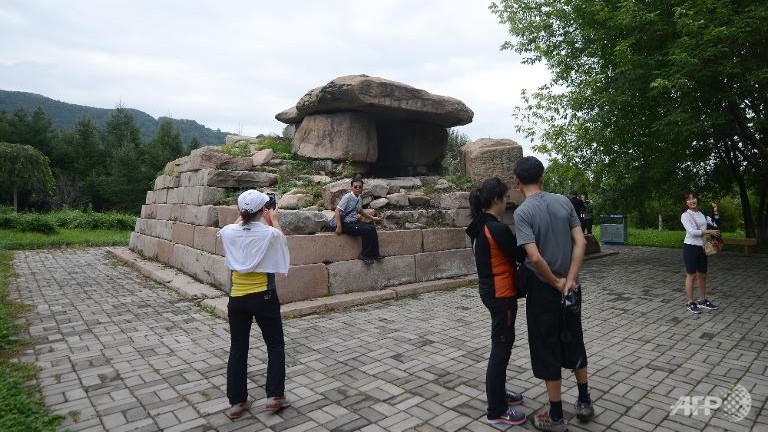JIAN – Centuries ago Kwanggaet'o the Great ruled over a mighty empire stretching from south of Seoul deep into Manchuria in China's northeast, but his Koguryo dynasty is now at the centre of a historical tug-of-war.
He is revered as a Korean national hero on both sides of the divided peninsula, while Chinese attempts to claim Koguryo as its own have provoked fury among its neighbours.
One of Koguryo's capitals, now the modern Chinese city of Jian, stands on the Yalu river on the frontier between China and Kim Jong-Un's North Korea.
It hosts a treasure trove of historical sites and cultural relics, including royal mausoleums designated as UNESCO World Heritage sites and decorated with murals depicting traditional wrestling and tiger-hunting.
A towering stone stele more than six metres (20 feet) tall illustrates the dispute, with Kwanggaet'o's name carved into the granite – on the classical Chinese characters used for writing in northeast Asia at the time.
"Koguryo is in fact part of Korean history, not Chinese history," said Hwang Seon-Goo, a South Korean visitor.
"We think that China insists on having its own way."
Soon afterwards Zhang Ming, who identified himself as a Chinese tourist, expressed keen interest in knowing what the South Korean visitor had said.
In response, he pointed to the language of the inscription as evidence of its Chineseness, asking "how it could be Korean" if it was written in Chinese.
The general Chinese view can be seen in a description in a Jian museum devoted to the dynasty. "Koguryo was engaged in wars with ancient central China and surrounding nations and tribes," reads one label.
"However, they finally accepted the authority of ancient central China dynasties and had a main historical trend of tributary kingdom."
The sensitivity of the issue is such that an AFP reporter visiting the museum was briefly detained by public security officials, before being ordered to leave Jian and followed out of town.
'A matter of national identity'
Koreans on both sides of the divided peninsula claim Koguryo as an inherent part of their history, and it is a popular theme in South Korea for novels and television dramas, such as this year's "The Blade and Petal", a tale of romance and political infighting toward the dynasty's close.
Koguryo lasted from at least 37 BC until 668 AD, when it was brought down by an alliance between Tang dynasty China and Silla, a rival Korean kingdom.
But the areas governed by the empire, spelled Goguryeo in South Korea and Gaogouli in China, lie in what today are four modern sovereign states: the two Koreas, China and Russia.
Tensions heated up about a decade ago when China launched the Northeast Project, a re-examination of the history of the country's border areas in the region.
Reaction was particularly negative in South Korea where the move was seen as an attempt to hijack Korean history, and even a possible prelude to Chinese designs on its ally North Korea were the ruling regime to collapse.
South Korea's foreign ministry devotes a section of its website to the topic, putting it on a par with the row with Japan over a disputed island called Dokdo by Seoul and Takeshima by Tokyo.
"The Korean government considers issues concerning the history of Goguryeo to be a matter of national identity, and thus places such issues among its highest priorities," the website says.
In 2006 South Korea's then president Roh Moo-Hyun reportedly raised the research personally with Wen Jiabao, China's premier at the time.
Tensions may have eased since but South Korea still keeps a close eye on "new cases of historical distortion", according to the foreign ministry.
Adam Cathcart, a lecturer in Chinese history at Britain's University of Leeds said: "When you look at North Korean relations with China, when you look at South Korean relations with China, it's an impediment, it's an irritant, it's something that all sides are watching."
Kwanggaet'o, who reigned from 391 to 413 and whose name is often translated as "broad expander of territory", is known in China as Haotaiwang. South Korea spells his name Gwanggaeto – and uses it for a class of its warships.
For its part North Korea – whose government proclaims a "military first" principle – also has numerous sites related to Koguryo and sometimes invokes the dynasty in its propaganda.
"Koguryo martial valour is something that is seen as very desirable from an historical exemplary point of view... for the North Korean leaders," said Cathcart, an expert in relations between Beijing and Pyongyang.
North Korea's young leader – who recently had his uncle executed – would undoubtedly want to visit the ancient tombs in Jian, he added.
"That's a photo op to die for for Kim Jong-Un," he said.
























































